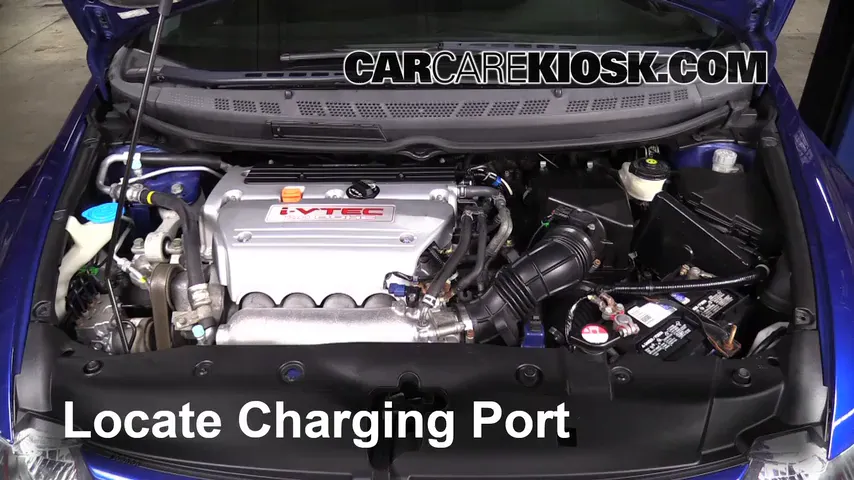As an Amazon Associate, I earn from qualifying purchases
Is your Honda Civic’s AC not blowing cold air like it used to? You’re not alone.
When the air conditioning starts to lose its chill, it can make every drive uncomfortable, especially on hot days. But here’s the good news: recharging your AC doesn’t have to be complicated or expensive. In this guide, you’ll learn simple steps to recharge your Honda Civic’s AC yourself, saving time and money.
Keep reading, and by the end, you’ll know exactly how to bring back that refreshing cool breeze every time you hit the road.

Credit: electricvehicleforums.com
Signs Of Low Ac Refrigerant
Knowing the signs of low AC refrigerant helps you keep your Honda Civic cool. Low refrigerant means the AC cannot work well. This causes discomfort during hot days. Spotting the problems early saves money and avoids bigger repairs.
Warm Air From Vents
One clear sign is warm air coming from the vents. The AC should blow cold air. If the air feels warm or just cool, refrigerant might be low. This happens because the system lacks enough cooling gas. Your Civic’s cabin will not cool down properly.
Unusual Noises
Listen for strange sounds when the AC runs. A hissing or bubbling noise may come from the AC system. These sounds often mean a refrigerant leak. The noise appears when gas escapes the system. This can cause the AC to lose power.
Reduced Cooling Efficiency
The AC might work but cool less than before. It takes longer to lower the temperature. The airflow may seem weaker too. Low refrigerant reduces the AC’s ability to cool fast. This makes driving uncomfortable in hot weather.
Tools And Materials Needed
Before recharging the AC in your Honda Civic, gather the right tools and materials. Using proper equipment ensures the job is safe and effective. This section lists what you need to complete the task.
Refrigerant Type For Honda Civic
Your Honda Civic uses a specific refrigerant type. Most models require R-134a refrigerant. Check your owner’s manual to confirm the exact type. Using the wrong refrigerant can damage the system.
Pressure Gauge Kit
A pressure gauge kit helps measure the AC system pressure. It shows if the refrigerant level is low or full. Choose a kit compatible with R-134a refrigerant. This tool is essential for accurate recharging.
Protective Gear
Safety is important during AC recharging. Wear gloves to protect your hands from cold refrigerant. Safety glasses shield your eyes from possible splashes. Proper gear prevents injuries and keeps you safe.
Preparing Your Honda Civic
Preparing your Honda Civic for AC recharging is the first important step. It helps ensure the process is safe and effective. Taking time to get ready can save effort later. Follow these simple steps before starting the recharge.
Park In A Safe Location
Choose a flat, open area to park your car. Avoid busy streets or places with heavy traffic. This keeps you and your vehicle safe. Make sure there is enough space around your car to work comfortably. A shaded spot can prevent overheating during the process.
Turn Off The Engine
Switch off your Honda Civic’s engine before beginning. This prevents any accidents or damage during recharging. Also, turn off the AC system to release any pressure in the lines. Wait a few minutes to let the system cool down before proceeding.
Locate The Ac Service Ports
Open the hood of your Civic carefully. Look for two AC service ports on the air conditioning system. One is the low-pressure port, the other is high-pressure. The low-pressure port is usually larger and easier to access. Identifying the right port is essential for correct recharging.

Credit: www.youtube.com
Steps To Recharge The Ac
Recharging the AC in your Honda Civic keeps the cabin cool and comfortable. Follow clear steps to do it safely and correctly. These steps help maintain your AC’s performance and extend its life.
Connect The Pressure Gauge
Start by locating the low-pressure port under the hood. Attach the pressure gauge to this port securely. Make sure the connection is tight to avoid leaks.
Check The Current Pressure
Read the pressure on the gauge with the engine running and AC on. Compare this reading to the recommended level in your car manual. This step shows if your AC needs more refrigerant.
Attach The Refrigerant Can
Attach the refrigerant can to the gauge hose. Hold the can upright to prevent liquid from escaping. Make sure the valve on the can is closed before attaching.
Add Refrigerant Slowly
Open the valve on the can slowly to release refrigerant into the system. Add the refrigerant in short bursts, not all at once. Watch the pressure gauge closely during this process.
Monitor Pressure Levels
Keep checking the pressure gauge as you add refrigerant. Stop adding when the pressure reaches the recommended level. Overcharging can damage the AC system.
Safety Tips During Recharge
Recharging the AC in your Honda Civic requires attention to safety. Handling refrigerants and equipment carefully protects you and your car. Follow these safety tips to avoid accidents and damage during the recharge process.
Avoid Overcharging
Overcharging the AC system can cause serious damage. It raises pressure inside the system, risking leaks or burst hoses. Always check the recommended refrigerant amount in your Civic’s manual. Use a gauge to monitor pressure levels closely during recharge.
Handle Refrigerant With Care
Refrigerants are harmful if not handled properly. Avoid direct contact with skin or eyes. Keep refrigerant containers upright and secure to prevent spills. Work in a well-ventilated area to avoid inhaling harmful fumes. Dispose of empty containers safely according to local rules.
Wear Protective Equipment
Protect yourself by wearing safety glasses and gloves. These prevent refrigerant from touching your skin or eyes. Long sleeves and closed shoes offer extra protection. Always keep a first aid kit nearby for emergencies during the recharge process.

Credit: www.carcarekiosk.com
Post-recharge Checks
After recharging the AC in your Honda Civic, some important checks ensure everything works well. These steps help keep your AC system efficient and safe. Follow them to avoid future problems and enjoy cool air inside your car.
Test The Ac Performance
Start your car and turn on the AC at the highest setting. Feel the air coming from the vents. It should be cold and steady. Notice any strange sounds or weak airflow. These signs may mean the recharge was not complete or there is another issue.
Inspect For Leaks
Look around the AC hoses and connections for any signs of oil or refrigerant leaks. Use a flashlight to see better in tight spots. Leaks reduce AC efficiency and can harm the system. Fix any leaks before driving your car more.
Clean Up And Store Tools
After finishing the recharge and checks, clean your tools carefully. Wipe off any refrigerant residue or dirt. Store everything in a safe place for future use. Keeping tools ready helps with quick repairs or recharges next time.
When To Seek Professional Help
Knowing when to seek professional help for your Honda Civic’s AC is important. Some problems need expert care to avoid damage. Professionals have tools and skills to fix issues safely and correctly. Trying to handle complex problems alone might cause more harm.
Persistent Cooling Issues
If your AC keeps blowing warm air after recharging, it needs professional attention. The problem might be a leak or a worn-out part. Experts can find hidden leaks and fix them. Persistent cooling issues often require special tools for proper diagnosis.
Complex Ac System Problems
AC systems include many parts like compressors, condensers, and sensors. Problems with these parts need expert repair. Professionals know how to handle refrigerant safely. Complex issues can cause system failure if not fixed properly. Avoid DIY repairs on these components to keep your AC safe.
Warranty And Service Considerations
Your Honda Civic may have a warranty covering AC repairs. Professional service helps keep the warranty valid. Unauthorized repairs might void warranty coverage. Taking your car to an authorized service center ensures quality work and warranty protection.
Frequently Asked Questions
How Do I Know When My Honda Civic Ac Needs Recharging?
Signs include weak airflow, warm air, or strange noises from the AC system.
What Tools Are Required To Recharge Ac In Honda Civic?
You need refrigerant, a pressure gauge, and a hose for safe recharging.
Can I Recharge My Honda Civic Ac Myself Safely?
Yes, with proper tools and following safety instructions, DIY recharging is possible.
How Long Does It Take To Recharge Ac In Honda Civic?
Recharging usually takes about 15 to 30 minutes depending on the AC condition.
Which Refrigerant Type Is Best For Honda Civic Ac Recharge?
Use the refrigerant type specified in your Honda Civic owner’s manual.
How Often Should I Recharge The Ac In My Honda Civic?
Typically, recharge every 1 to 2 years or when cooling efficiency drops.
Conclusion
Keeping your Honda Civic’s AC cold is important for comfort. Regularly checking and recharging the AC helps it work well. Follow the steps carefully to avoid mistakes. Use the right tools and refrigerant for your car model. Taking small actions can save time and money later.
Stay safe and handle refrigerants with care. A cool ride makes every drive better and more enjoyable.
As an Amazon Associate, I earn from qualifying purchases


